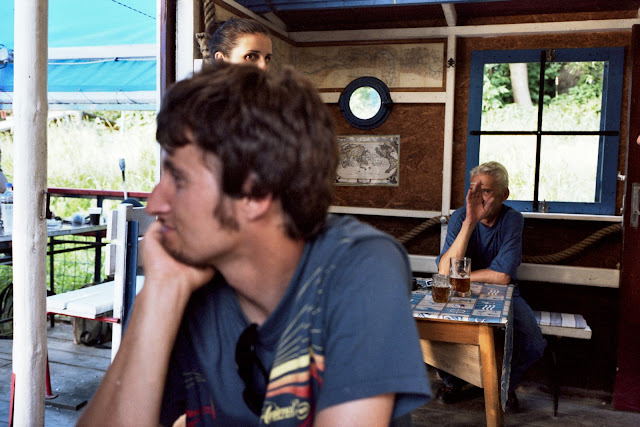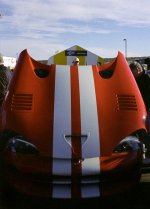ishpop
tall person
I just got back my first roll of this film. I did not intentionally push or pull, just shot at ISO 400 and generally exposed with my Olympus OM1n meter in the center.
Some shots were slightly underexposed, but I did not expect the ammount of grain I am seeing, here are a few samples:
an underexposed shot:

One more underexposed:

and here is one that turned out not so bad:

I guess I dont mind some grain of course, but some of the shots were un-usable, so is my lesson learned here that this film needs to be exposed amply or even over-exposed a tad to get ideal results?
Or is my scanner bringing more noise into the fray than is actually there?
I have an Epson Perfection 4490 and I tried about every setting I could to tweak to see if I could get better results...
Some shots were slightly underexposed, but I did not expect the ammount of grain I am seeing, here are a few samples:
an underexposed shot:

One more underexposed:

and here is one that turned out not so bad:

I guess I dont mind some grain of course, but some of the shots were un-usable, so is my lesson learned here that this film needs to be exposed amply or even over-exposed a tad to get ideal results?
Or is my scanner bringing more noise into the fray than is actually there?
I have an Epson Perfection 4490 and I tried about every setting I could to tweak to see if I could get better results...
M
M like Leica M6
Guest
These images seem to be seriuosly underexposed. But it could also be that your lab ruined the film. Who developed it?
Did you switch off all sharpening in your scan software? Many scanners still sharpen images even if you switch it off, but that is something only another Epson user can explain.
BTW, for this kind of images you will be better off with the "NC" versions of Portra, the "VC" is too gaudy for many purposes, it's more for the "Pete Turner Kodachrome style".
Did you switch off all sharpening in your scan software? Many scanners still sharpen images even if you switch it off, but that is something only another Epson user can explain.
BTW, for this kind of images you will be better off with the "NC" versions of Portra, the "VC" is too gaudy for many purposes, it's more for the "Pete Turner Kodachrome style".
Last edited by a moderator:
Thardy
Veteran
I tried scanning the same film sometime ago. As I remember, most shots looked like #3 and some like #1 of your examples.
palec
Well-known
Strange, these are my results of scanning Portra 400VC with Epson V700 plus some adjusting in PS.






pphuang
brain drain...
I usually over-expose portra a bit to get the best results, but box speed is usually OK and the negatives scan very well. It tends to look grainy and coarse when under-exposed - maybe your meter is off, or the processing was screwed up...
ishpop
tall person
Thanks for the tips guys. I will have a gander with Vuescan free version to see if its my software, but I am thinking its just under exposure...
maddoc
... likes film again.
I get mostly the same, grainy and a little dull results, when I scan slightly underexposed color-negative film (any of them) with the Epson V700 and exposure set to auto. From my experience, the Epson software tries to lighten up dark areas to much, so I manually adjust levels for nearly every frame before scanning.
Glenn2
Well-known
Ishpop, you don't mention what scanner you are using. You may be seeing an effect called grain aliasing.
See this link for more information....
http://www.photoscientia.co.uk/Grain.htm
If you happen to be using a Minolta scanner this may be a possible fix...
http://www.scanhancer.com/
Glenn
See this link for more information....
http://www.photoscientia.co.uk/Grain.htm
If you happen to be using a Minolta scanner this may be a possible fix...
http://www.scanhancer.com/
Glenn
maddoc
... likes film again.
Ishpop, you don't mention what scanner you are using. You may be seeing an effect called grain aliasing.
See this link for more information....
http://www.photoscientia.co.uk/Grain.htm
If you happen to be using a Minolta scanner this may be a possible fix...
http://www.scanhancer.com/
Glenn
Very useful links !
The OP mentioned that he used an Epson Photo Perfection 4490 (last line under the photos in his first post)
ishpop
tall person
Really interesting article!
I will try the defocus trick and see how it works...
I will try the defocus trick and see how it works...
Ishpop, you don't mention what scanner you are using. You may be seeing an effect called grain aliasing.
See this link for more information....
http://www.photoscientia.co.uk/Grain.htm
If you happen to be using a Minolta scanner this may be a possible fix...
http://www.scanhancer.com/
Glenn
Dektol Dan
Well-known
Very underexposed, but remember the faster color negative films have much more contrast, the lower the contrast the the better your luck will be. The same applies to your lens. Go for a less contrast lens when using a scanner for your dark room.
The shot of the Viper is 400 Fuji, the Carney is 160 Porta.
Scanners have have giant struggles with D-max in both high density slides and low density color negatives. You have to stay in the comfortable middle.
I never over expose Porta, I always over expose Fuji by 1/2 stop.
The shot of the Viper is 400 Fuji, the Carney is 160 Porta.
Scanners have have giant struggles with D-max in both high density slides and low density color negatives. You have to stay in the comfortable middle.
I never over expose Porta, I always over expose Fuji by 1/2 stop.
Attachments
Last edited:
ishpop
tall person
BTW Palec, your results look great, I definitely need to try another roll and see if I can get it improved.
palec
Well-known
I meter for shadows when exposing negatives.
Just curious, what is the edgeprint on your negative - 400VC, 400VC-2 or 400VC-3?
Just curious, what is the edgeprint on your negative - 400VC, 400VC-2 or 400VC-3?
wray
Well-known
Yes, something's amiss with either the developing or exposure. Here's a Portra 400 VC sample:


robertdfeinman
Robert Feinman
Your film is either underexposed or underdeveloped, or it could be out of date or
spoiled film.
Take another roll, shoot in bright sun and bracket above and below the sunny 16 rule. Then take the film somewhere else to be processed.
If you like you can also repeat the experiment in open shade centering around f5.6.
(The shutter speed is, of course, the film speed (1/500 for 400 speed film.)
There might also be something wrong with your camera. You can try a series of
shots that are supposed to produce the same results: 1/500 at f5.6, 1/250 at f8, etc.
The Epson scanners need a bit of babying. The don't perform as well as their rated resolution claims. I have some tips on how to deal with this on my web site. This won't affect the grain problem, but will give you "sharper" scans.
All modern 400 speed films give excellent results. Most can be made to look like any of the others by suitable contrast and saturation changes in image editing software afterwards. The reason for there still being various versions is part marketing (like all the various types of toothpaste) and partly to appeal to those few photographers who go straight from film to (non-digital) prints.
There may still be a few wedding and commercial photographers who do this, but I think most of the reason for the different formulations is because the other brands offer them as well.
I shoot the "amateur" formulations and have never found any drawbacks.
spoiled film.
Take another roll, shoot in bright sun and bracket above and below the sunny 16 rule. Then take the film somewhere else to be processed.
If you like you can also repeat the experiment in open shade centering around f5.6.
(The shutter speed is, of course, the film speed (1/500 for 400 speed film.)
There might also be something wrong with your camera. You can try a series of
shots that are supposed to produce the same results: 1/500 at f5.6, 1/250 at f8, etc.
The Epson scanners need a bit of babying. The don't perform as well as their rated resolution claims. I have some tips on how to deal with this on my web site. This won't affect the grain problem, but will give you "sharper" scans.
All modern 400 speed films give excellent results. Most can be made to look like any of the others by suitable contrast and saturation changes in image editing software afterwards. The reason for there still being various versions is part marketing (like all the various types of toothpaste) and partly to appeal to those few photographers who go straight from film to (non-digital) prints.
There may still be a few wedding and commercial photographers who do this, but I think most of the reason for the different formulations is because the other brands offer them as well.
I shoot the "amateur" formulations and have never found any drawbacks.
ishpop
tall person
Your film is either underexposed or underdeveloped, or it could be out of date or
spoiled film.
Take another roll, shoot in bright sun and bracket above and below the sunny 16 rule. Then take the film somewhere else to be processed.
If you like you can also repeat the experiment in open shade centering around f5.6.
(The shutter speed is, of course, the film speed (1/500 for 400 speed film.)
There might also be something wrong with your camera. You can try a series of
shots that are supposed to produce the same results: 1/500 at f5.6, 1/250 at f8, etc.
The Epson scanners need a bit of babying. The don't perform as well as their rated resolution claims. I have some tips on how to deal with this on my web site. This won't affect the grain problem, but will give you "sharper" scans.
All modern 400 speed films give excellent results. Most can be made to look like any of the others by suitable contrast and saturation changes in image editing software afterwards. The reason for there still being various versions is part marketing (like all the various types of toothpaste) and partly to appeal to those few photographers who go straight from film to (non-digital) prints.
There may still be a few wedding and commercial photographers who do this, but I think most of the reason for the different formulations is because the other brands offer them as well.
I shoot the "amateur" formulations and have never found any drawbacks.
Thanks alot for the info Robert.
I have a few more rolls to use so I will try your recommended test.
I have about 7 rolls of Elite Chrom 400 so maybe that will give me a sense of whether there's anything amiss with my meter, but I suspect not, just had Camtech CLA last year and only shot about 8 rolls.
Regarding the Q about which version of 400vc, I will check when I get home tonight.
I also might put the next Portra roll through my Bessa which i know the meter is dead on.
allen_a_george
Established
Hmm. . . I'm having the same issue as the OP with both Portra 400VC . I'm using a V500 (successor to the 4490?). Most of my photos turn out like #1, a few like #3. I had two from a roll of 400NC turn out like #2. That was the worst grain I'd ever seen  That said, I'm using expired VC and NC, and their edgeprints read "400VC" and "400NC" respectively - guess this means it's the older versions of these films.
That said, I'm using expired VC and NC, and their edgeprints read "400VC" and "400NC" respectively - guess this means it's the older versions of these films.
BTW, have you tried prints? My prints came out looking infinitely better than the scans. And turn off any USM in Epson Scan - it really accentuates the grain.
I'd love to get scans like Palec does - I just can't!
BTW, have you tried prints? My prints came out looking infinitely better than the scans. And turn off any USM in Epson Scan - it really accentuates the grain.
I'd love to get scans like Palec does - I just can't!
MaxElmar
Well-known
Looks like bad processing to me. Really bad. Very common nowadays, sadly.
Share:
-
This site uses cookies to help personalise content, tailor your experience and to keep you logged in if you register.
By continuing to use this site, you are consenting to our use of cookies.


